The not-so-much underdog (Pentax) Super-Takumar 85mm f/1.9 on the bench with an APS-C 24MP sensor
| lens name: | Super-Takumar 85mm F1.9 | ||
| angle of view (diagonal): | 29° (full frame), 19° (APS-C) | blades: | 6 |
| macro: | NO | min focus: | 85cm (magnification 0.13x) |
| elements: | 5 | groups: | 4 |
| filter size: | 58mm | focus: | manual |
Preamble
A few things I must say first...
- I'm writing in English because I'd like to share my lens tests with a wide audience, forgive me when it's bad English!
- About the camera of choice for, the Fujifilm XH-1, I repeat it every time (sorry): 24 megapixels are probably enough to benchmark most legacy lenses (16MP are insufficient, in my experience, though the subject is more complex then it seems). The in-camera JPEG processing of the Fuji is unmatched. It saves a lot of time with tests, you can't do much better with manual, ad-hoc processing, and anyway it cuts the mustard if the purpose is to give a precise idea of the lenses quality.
And now, let's go...
To read more about the Pentax Super-Takumar 85mm F1.9, check this page (PentaxForums is definitely the source for Pentax equipment).
A quick assessment
What follows is more or less what I have posted on the
Pentax Forums site, it may spoil all the fun but since I'm not going to write a long review, I think
it is sufficient for the impatient reader and a quick evaluation:
I hate screw lenses, I love bajonets. I promised myself not to buy any more M42 lenses, never ever. And here I am. When I saw this jewel in pristine condition (I mean really like it just came of the shop, in spite of decades passed by), with the focus ring buttery, firm and precise (I mean better than my two Zeiss Distagons!), the mechanics incredibly tight, no sign of wobbling... the original all-metal cap and hood, etc. well, could I resist?
The lens is marked "Super-Takumar 85mm F1.9" and the minimal aperture is f/16 (there are three variants, apparently they perform the same). Obviously, in the "f/1.9" lays the allure of this product, but there is more.
I have taken just a few shots, at f/1.9 and f/2 at close distance and f/5.6 and f/8 at a tower 200m away, more or less (let's say "infinity").
I did my best to carefully focus and the results are very satisfactory, much beyond my expectations. The optic is very sharp in the centre even at f/1.9 and surprisingly sharp at APS-C corners in both scenarios, and that's unusual since often lenses are better at short distance or far distance, not both.
Technically speaking, here sharpness comes from resolution, not contrast.
Sorry I cannot tell about full-frame performance.
The bokeh seems very good, too, even though I haven't really checked the different cases.
Bokeh balls are even but lack magic. You can expect that from the type and number of diagphragm blades.
Alas, axial chromatic aberration is not negligible and it is hard to correct via software.
There is some lateral CA but it's hardly noticeable.
I should better check as soon as I can, with a more contrasty image; indeed, the long-distance shots are contrasty but the CA is practically absent there, good!
Microcontrast is not strong, I'd say just "fair" (which is not bad at all), but it's something that can be easily dealt with at edit time, if you need more "pop".
In brief, there is nothing to complain about mechanics, this lens is a jewel.
Optically, it's not perfect but the actual shots are very pleasant, and one must definitely take into account the age of the lens and the very wide aperture, that poses problems of its own, to the optic designers at least.
The main problem I see comes from its weight and bulkiness. The Fujifilm XH-1 is not a small camera like its siblings and yet this 85mm is a bit on the heavy side for it, I think it's a better match for a full-frame camera or a heavier camera.
The M42 ring is an attractive option for many photographers, but I will probably resell this lens just because I precisely hate screws (M42 or not) and since I own a Sonnar I can live without this Pentax; it's a really tough decision. Definitely, it's one of the best Pentax/Takumar lenses I have ever put my hands on, in spite of its flaws it exerts an inexplicable appeal on me.
If I had the same lens with the bajonet, also considering that the Sonnar is not so wide... I'd possibly give away the German lens, instead!
I hate screw lenses, I love bajonets. I promised myself not to buy any more M42 lenses, never ever. And here I am. When I saw this jewel in pristine condition (I mean really like it just came of the shop, in spite of decades passed by), with the focus ring buttery, firm and precise (I mean better than my two Zeiss Distagons!), the mechanics incredibly tight, no sign of wobbling... the original all-metal cap and hood, etc. well, could I resist?
The lens is marked "Super-Takumar 85mm F1.9" and the minimal aperture is f/16 (there are three variants, apparently they perform the same). Obviously, in the "f/1.9" lays the allure of this product, but there is more.
I have taken just a few shots, at f/1.9 and f/2 at close distance and f/5.6 and f/8 at a tower 200m away, more or less (let's say "infinity").
I did my best to carefully focus and the results are very satisfactory, much beyond my expectations. The optic is very sharp in the centre even at f/1.9 and surprisingly sharp at APS-C corners in both scenarios, and that's unusual since often lenses are better at short distance or far distance, not both.
Technically speaking, here sharpness comes from resolution, not contrast.
Sorry I cannot tell about full-frame performance.
The bokeh seems very good, too, even though I haven't really checked the different cases.
Bokeh balls are even but lack magic. You can expect that from the type and number of diagphragm blades.
Alas, axial chromatic aberration is not negligible and it is hard to correct via software.
There is some lateral CA but it's hardly noticeable.
I should better check as soon as I can, with a more contrasty image; indeed, the long-distance shots are contrasty but the CA is practically absent there, good!
Microcontrast is not strong, I'd say just "fair" (which is not bad at all), but it's something that can be easily dealt with at edit time, if you need more "pop".
In brief, there is nothing to complain about mechanics, this lens is a jewel.
Optically, it's not perfect but the actual shots are very pleasant, and one must definitely take into account the age of the lens and the very wide aperture, that poses problems of its own, to the optic designers at least.
The main problem I see comes from its weight and bulkiness. The Fujifilm XH-1 is not a small camera like its siblings and yet this 85mm is a bit on the heavy side for it, I think it's a better match for a full-frame camera or a heavier camera.
The M42 ring is an attractive option for many photographers, but I will probably resell this lens just because I precisely hate screws (M42 or not) and since I own a Sonnar I can live without this Pentax; it's a really tough decision. Definitely, it's one of the best Pentax/Takumar lenses I have ever put my hands on, in spite of its flaws it exerts an inexplicable appeal on me.
If I had the same lens with the bajonet, also considering that the Sonnar is not so wide... I'd possibly give away the German lens, instead!
Focus, construction, handling
Mechanically speaking, this lens is simply a top-notch product; it feels very solid and "responding" in your hands.
It is a full-metal piece, heavy but not terribly so.
My copy is simply flawless in terms of mechanics, in spite of the decades that have passed since its production, I don't know how I could better praise it.
The focus ring feels incredibly massive and I like the grip.
Focus control is excellent, with perfect resistance; the focus throw is rather long, how much you like this is a matter of taste.
To nail down the subject in the focus area can be hard at full aperture, but at f/1.9 what else would you expect?
The minimal focus distance is 85cm, this optic is definitely not a macro lens but is well-suited for close portraits, so it's OK but don't count on it for the occasional shots of insects and alike.
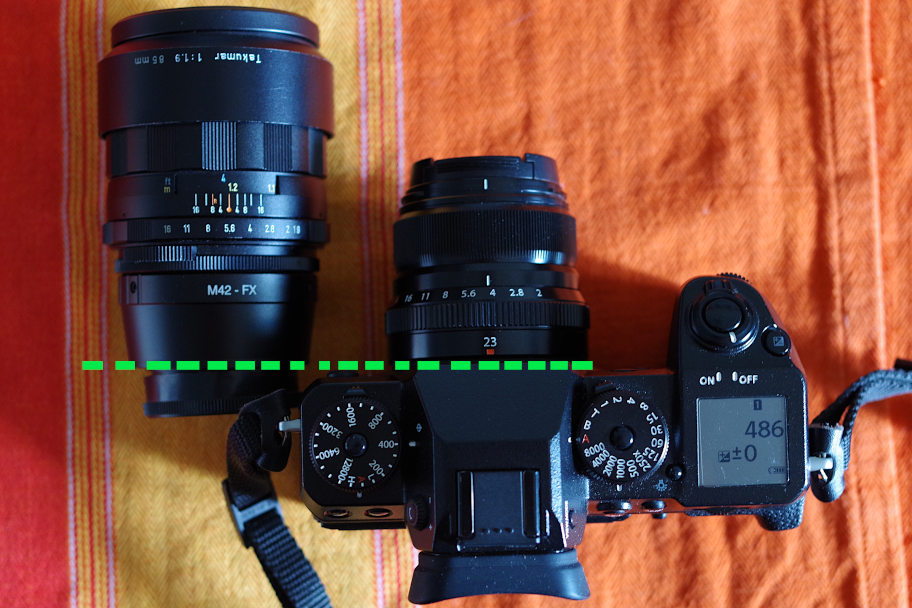
The Super-Takumar 85mm put aside the XH-1.
By itself, it's not a long lens, but if you attach it to the XH-1, counting the length of the adapter, it protrudes quite a bit and handling is sub-optimal; the green line superimposed on the image shows where the adapter fits on the camera. The whole goes well beyond the length of the Fujinon 23mm, though not a fair comparison it gives you the idea.
Adapters, specifically from M42 screw to Fujifilm FX bajonet, are very common and there are many brands producing them, the one here (it's attached to the lens) is cheap but fine.
Notice that, by the time of writing, I also have reviewed two other 85mm lenses: the Pentax-M 85mm/2 and the Zeiss Sonnar 85mm/2.8. If I had to choose only one among them I would feel very embarrassed, but as for mechanics I'd say the Super-Takumar is the best though by a small margin over the Sonnar.
It's also the one a bit harder to handle, because of the weight (350g vs 260g of the Sonnar).
Aperture, aperture ring
The Super-Takumar 85mm sports a min aperture of f/1.9, there lies the main feature of the lens in comparison with others.
I'm probably becoming boring, at this point, but I'd say that the aperture ring of the lens is very precise and provides the right amount of resistance, more or less like the aforementioned Zeiss Sonnar.
Contrast, colours, saturation
The Super-Takumar 85mm f/1.9 shows good contrast (but nothing to rave about) and colours.
I can't see the "pop" produced by strong microcontrast in some other lenses but, in spite of that, the general image quality is very pleasing. Well done!
Bokeh, bokeh balls
The first shots I took don't say much about the bokeh, it seems very good but I'll try to do better.
For the moment, try to make your considerations based on the few shots in this page.
Bokeh balls are pleasantly even at f/1.9 but the cat-eye effect is evident. I never found it a distracting element, but undoubtly perfectly big and round balls in the whole image area can produce "magic" images, an effect which cannot be obtained with the Takumar.
The shape of the opening produced by the diagphragm blades is pretty obvious at f/2.8, but at least the cat-eye effect is gone, a meagre consolation.
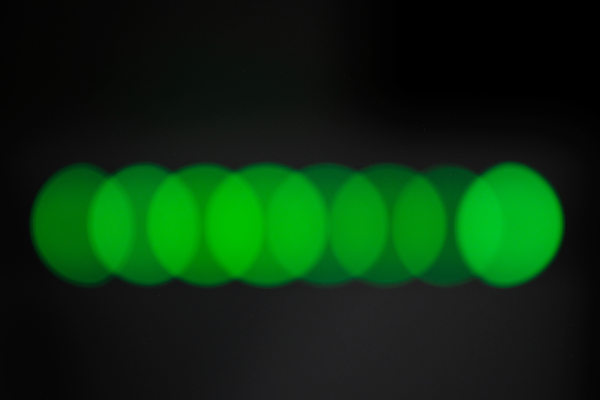

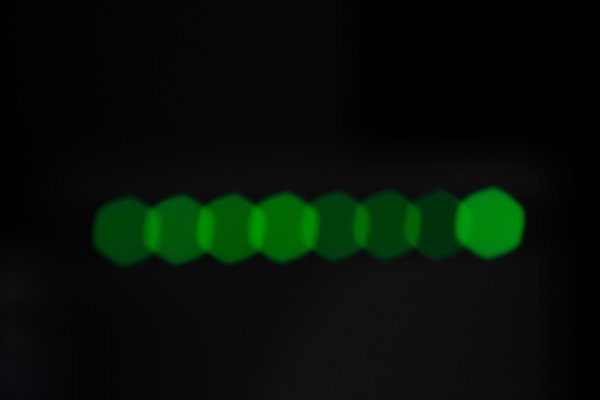

Axial CA, spherochromatism
I am sorry but it is hard for me to tell the difference between "defocus colour aberration" and "spherical CA aberration" (aka spherochromatism).
The Super-Takumar 85mm f/1.9 shows a pretty amount of this sort of aberration[s].
The two images that follow have been shot at f/1.9 and f/2.8, respectively. The printed characters are all of the same grey (you see some deviation from pure grey because of the artificial light) but the image clearly shows different tints for characters behind the focus zone and those in front of it, red-magenta and green, respectively.
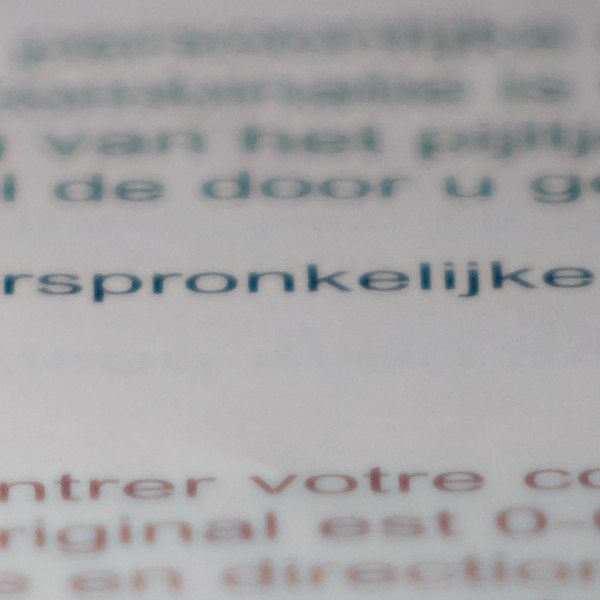 at f/1.9
at f/1.9
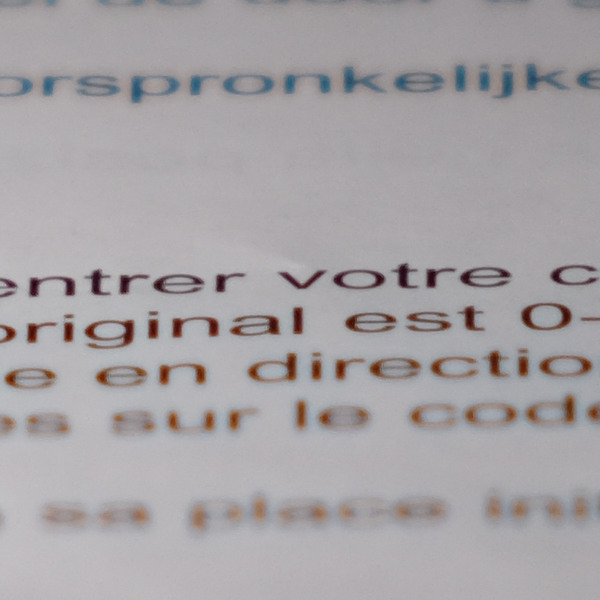 at f/2.8
at f/2.8
Analysis of studio images (close portrait distance)
center at f/1.9
Studio images are what you're waiting for, if you're in the portrait business.Well, this lens may be the right choice, let's see why...
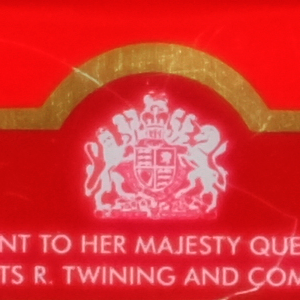 f/1.9, 100% crop, image centre
f/1.9, 100% crop, image centreas straight from the camera
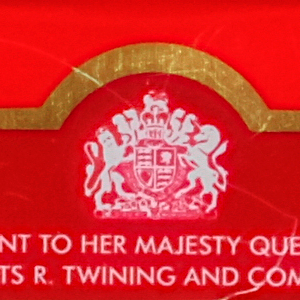 f/1.9, 100% crop, image centre
f/1.9, 100% crop, image centre+ mild sharpening in post-processing
The images above are the same 100%-magnification crop from the centre of a shot taken at short distance from the tea box, though the former is just as it comes from the camera, the latter with sharpening applied in post-processing.
The "original" displays some mild diffusion (portrait people usually like it), but if you want to force sharpness you can get excellent results, the information is all there, not bad, huh?!
center at f/2.0
At f/2 you're just closing the diaphragm a bit, the sharpness at the centre shows some very minor improvement,
possibly due to a bit more contrast. But it's really negligeable. I have applied some more sharpening in the second image.
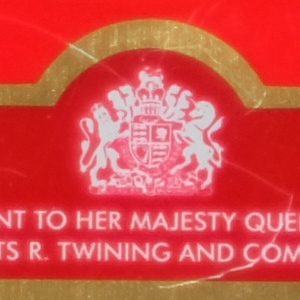 f/2.0, 100% crop, image centre
f/2.0, 100% crop, image centreas straight from the camera
 f/2.0, 100% crop, image centre
f/2.0, 100% crop, image centre+ sharpening in post-processing
centre at f/2.8
At f/2.8 is where things get interesting. Most often with this kind of lens, this is the sweet spot where sharpness increases
significantly but the lens still retains a shallow depth of field for the best IQ.Is it the case, here? I'd say definitely yes. You can see how microcontrast went up and how much detail is evident even without post-processing.
Anyway, some is applied in the second image, I have forced my hand to the point where some noise is present, but according to me this image can be printed with a size of 18x12" (45x30 cm) with excellent results.
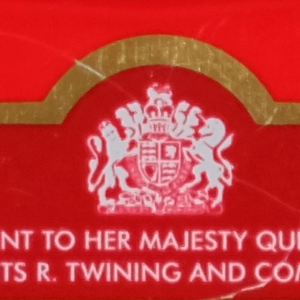 f/2.8, 100% crop, image centre
f/2.8, 100% crop, image centreas straight from the camera
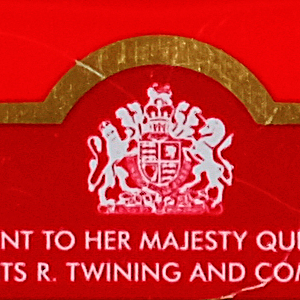 f/2.8, 100% crop, image centre
f/2.8, 100% crop, image centre+ post-processing
centre at f/4
Needless to say, the centre improves closing the diagphragm to f/4, though the quality was already excellent at f/2.8.I produce the usual two images, here. Notice the horse's face and the mouth of the lion, now you can spot the tiniest details.
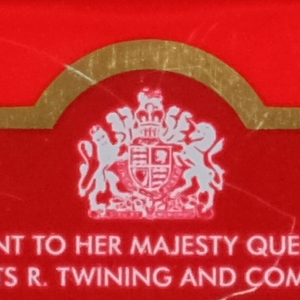 f/4.0, 100% crop, image centre
f/4.0, 100% crop, image centreas straight from the camera
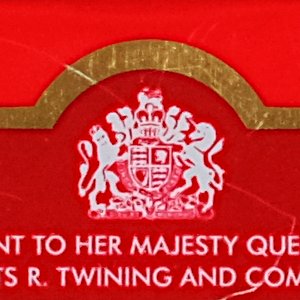 f/4.0, 100% crop, image centre
f/4.0, 100% crop, image centre+ post-processing
centre at f/5.6
At f/5.6, sharpen tools in post-processing have a relative impact on the perception of details, but augmenting
the sharpen, contrast or working on the curves is still effective to improve the IQ.
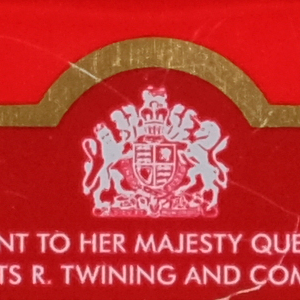 f/5.6, 100% crop, image centre
f/5.6, 100% crop, image centreas straight from the camera
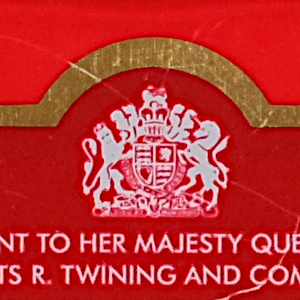 f/5.6, 100% crop, image centre
f/5.6, 100% crop, image centre+ mild post-processing
mid-top at f/1.9
It is important to check what happens off the centre before taking care of the corners.At f/1.9, the performance is good in the middle position of the top side of the picture (remember this is APS-C).
Consider that some softness at full aperture is desired for most buyers of portrait lenses, and here you find some, but the details are all there, with some diffusion. Yes, there are better performers in this area, but you won't find many among legacy optics and with such wide aperture. And if you find one, I'm sure you'll pay a lot for it.
 f/1.9, 100% crop, middle of the top side
f/1.9, 100% crop, middle of the top sidestraight from the camera
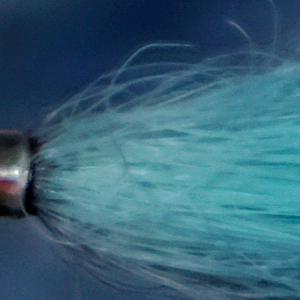 f/1.9, 100% crop, middle of the top side
f/1.9, 100% crop, middle of the top side+ mild post-processing
corner at f/1.9
Both this crop and others I've checked prove that the performance of the lens is quite flat, at f/1.9,
down to the APS-C corners.
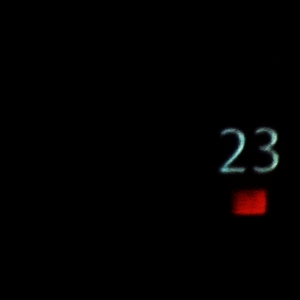
f/1.9, 100% crop, corner
no sharpening applied, just edited the luminosity curve
Above is a white mark, part of the Fujifilm 23mm digital era lens, on the black
of the its barrel. Clarity is quite satisfactory, but I'd like to add some other crops of a subject that
has much less contrast, to show how details outlined as well.
Output at infinity
The results at infinity are good but not as good of those for shorter distances. This is especially evident if I compare the shots to some taken with the Sonnar 85mm.
And yet, as you will see from the crops hereunder, there is a lot of detail to be highlighted with some mild post-processing, both in the centre and the corners.
In my non-scientific evalutation but in technical terms, I see a moderate contrast (technically: acutance) but very good if not excellent resolution (the details of the antenna make a good sample). So, sharpness is mostly there, and a bit of post-processing can help a lot. But if you want excellence straight from the camera, it is not the case.
Aberrations are minor, in this regard the lens behaves better than many Pentax items that show some (or much) annoying lateral CA.
I produce here just some shots taken at f/8; at f/5.6 the results are satisfactory as well but you can perceive a small difference. f/8 is probably the sweet spot for long-distance photos with the Takumar 85mm.
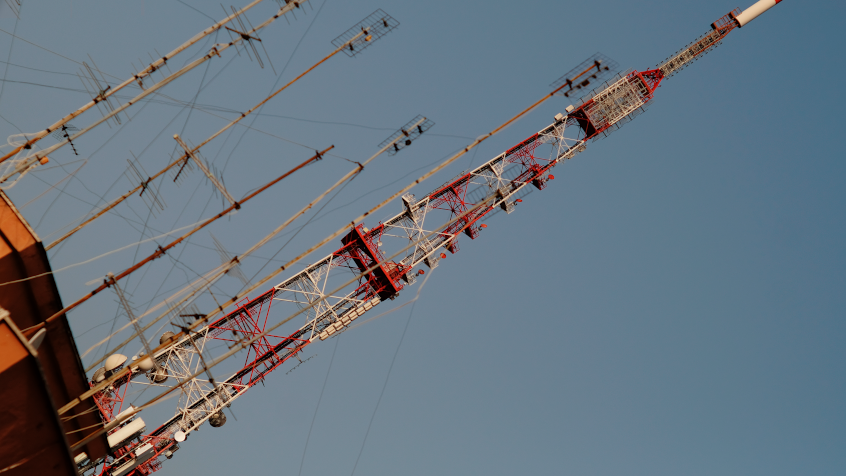
The subject for the photo taken from a distance. The sky is clear, the contrast acceptable... should be the right scene!
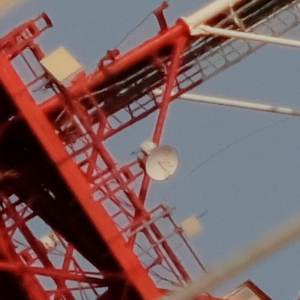 f/8, 100% crop, centre
f/8, 100% crop, centre
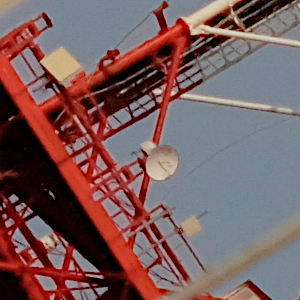 f/8, 100% crop, centre, sharpened in post-processing
f/8, 100% crop, centre, sharpened in post-processing
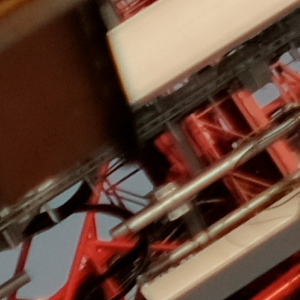 f/8, 100% crop, corner
f/8, 100% crop, corner
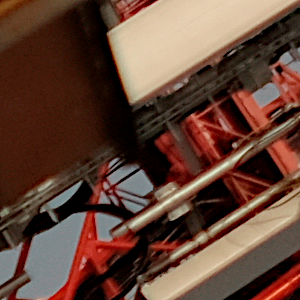 f/8, 100% crop, corner, after some post-processing
f/8, 100% crop, corner, after some post-processing
As for sharpness, you can see with your own eyes that the lens is good but there are better options for long distance shots, and if I were in you I wouldn't buy this lens for the task anyway, it's heavy to carry around and you don't need f/1.9 for the purpose.
But if you happen to have it already, it won't do a bad job.
Conclusion
In the quick assessment I've actually said it all.
The Asahi 85mm f/1.9 is a beautiful lens, with outstanding mechanics and very good optics, probably among the best Asahi Pentax of its era, before the excellent Pentax-A line was available.
Good modern competitors (forget about the cheap alternatives) are optimized for the digital sensors and can certainly do better on modern cameras, but they cost a lot more and they don't share the same look nor the same feel in terms of grip, firmness, etc. and don't expect much of a difference as for the general image quality.
The only real downsides for this excellent piece are the axial CA and the weight, as already stated. It was meant for the full-frame league, hence most APS-C cameras are too small in comparison and can't constitute the perfect match.
Obviously autofocus at times can be a must, in such case you'll have to turn elsewhere and check lenses produced in more recent times.
The Super-Takumar 85mm in all its hefty, metal beauty, with the original cap and screen.